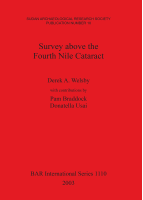Description
BOOK DESCRIPTIONIn December 1952, the new Egyptian Government decided to construct the Aswan High Dam. In the late 1970s and 1980s the construction of a dam at the Fourth Cataract, known as the Merowe Dam, was again mooted (Hakim 1993, 1-2), while another was proposed at the Kajbar rapids a little downstream of the Third Cataract. In response to the threat posed to the antiquities of the Fourth Cataract region the Sudan Archaeological Research Society undertook a single season of survey (November/December 1999). Although the concession granted included the whole of the left bank, over a distance of 40km, and the islands between the two forts at Dar el-Arab (Suweiqi) and Jebel Musa (Kirbekan), at the downstream end of Boni Island, the wealth of archaeological sites coupled with the difficulties of travel in the region meant that only small areas were examined in detail (1km along the left bank in the vicinity of the village of Gereif; Birti Island and four other small islands; the left bank from a little upstream of Birti; ten islands immediately downstream of el-Tereif). Most of the sites located were described, sketch plans were made where appropriate and many were also surveyed in detail, plans being produced at a scale of 1:500 or 1:100. Artefacts were also collected either from each feature or from transects across the sites and this material was studied by the pottery, lithics and small finds specialists. Many of the rock pictures were traced onto acetate and their locations plotted by GPS or in relation to their local environment by total station. A detailed description of the sites surveyed is contained in the gazetteer which is followed by an analysis of the pottery, small finds and lithics. The results detailed in this volume are advanced tentatively and it isfully expected that further survey work and excavation will modify the conclusions arrived at here. However, in the light of the current situation where it seems likely that the dam will be built in the very near future, and of the need for the archaeological community to seriously address the loss of a vast number of archaeological sites along one of the least known stretches of the Nile Valley, it was felt to be desirable that this work be brought to publication as soon as possible. It offers a glimpseof the richness and diversity of the remains of human activity in what is generally considered one of the most inhospitable regions of the valley, over many millennia.











